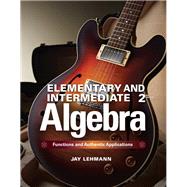Using authentic data to make math meaningful to students, Jay Lehmann’s algebra series uses a curve-fitting approach to model compelling, real-world situations, while answering the perennial question “But what is this good for?” Beginning with interesting data sets, students are asked to find models and derive equations to fit a scenario, helping them to understand functions graphically, numerically, and symbolically. Updated exercises, labs, and graphs deepen students’ understanding of core concepts and keeps them motivated to learn.
ALERT: Before you purchase, check with your instructor or review your course syllabus to ensure that you select the correct ISBN. Several versions of Pearson's MyLab & Mastering products exist for each title, including customized versions for individual schools, and registrations are not transferable. In addition, you may need a CourseID, provided by your instructor, to register for and use Pearson's MyLab & Mastering products.
Packages
Access codes for Pearson's MyLab & Mastering products may not be included when purchasing or renting from companies other than Pearson; check with the seller before completing your purchase.
Used or rental books
If you rent or purchase a used book with an access code, the access code may have been redeemed previously and you may have to purchase a new access code.
Access codes
Access codes that are purchased from sellers other than Pearson carry a higher risk of being either the wrong ISBN or a previously redeemed code. Check with the seller prior to purchase.
--
0321927923 / 9780321927927 Elementary & Intermediate Algebra: Functions and Authentic Applications Plus MyMathLab Access Card
Package consists of:
0321431308 / 9780321431301 MyMathLab -- Glue-in Access Card
0321654064 / 9780321654069 MyMathLab Inside Star Sticker
0321922727 / 9780321922724 Elementary & Intermediate Algebra: Functions and Authentic Applications








